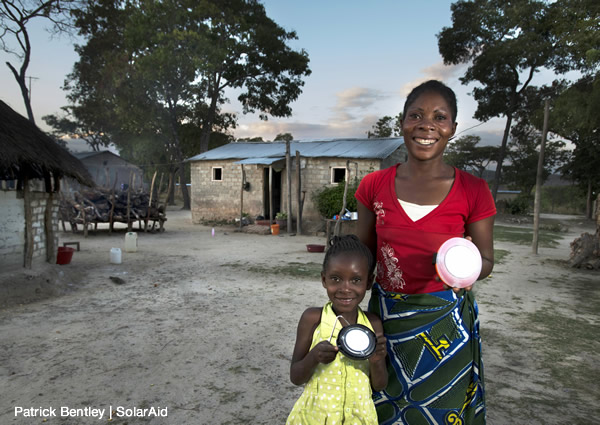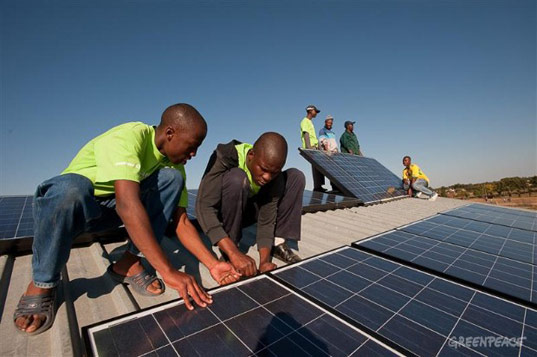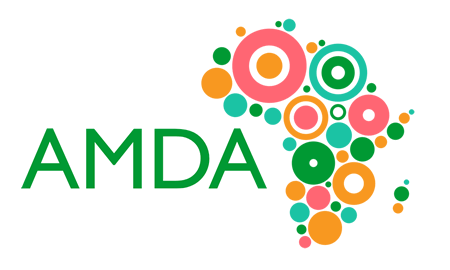Contrary to popular belief, it is not the US and Europe that are leading the transition to clean energy. It’s the developing world. According to the Bloomberg New Energy Finance (BNEF) “Climatescope” project, in 2017, a large majority of global renewable energy projects were built in developing countries, reversing the trend of the last decade. 1
Africa is no exception to this new trend, making impressive progress in tackling energy access, and that’s partly because of increasing recognition that the fastest and least expensive path to electrification in developing countries is via distributed renewable energy.

However, the fact remains that over 640 million Africans – or two thirds of the continent’s population – still lack access to electricity. Energy poverty saps economic growth, handicaps the development of self-sufficient local communities, and threatens security. Furthermore, there’s an enormous urban-rural divide, with about 60% of the urban population able to access electricity compared to only 15% of the rural population.
Lack of energy is also part of the dynamic that is driving urban migration. African cities are growing much faster than other cities around the world, and the influx into poor, urban neighborhoods without necessary infrastructure creates inadequate living conditions and destabilizes communities.
Meanwhile, the ongoing pursuit of energy policies that would replicate the centralized utility models of the developed world have not succeeded in improving energy access in Africa. Many governments and utilities are still advocating for expansion of traditional grid infrastructure. But in most places, the current grid is not delivering reliable electric power to its urban customers, let alone to new rural customers.

Many communities, even if they have access to the central grid, have to supplement poor quality power with diesel generators to compensate for brownouts and frequent power failures. Meanwhile, utilities struggle to collect revenues from their customers because of rampant electricity theft and political pressure to set unsustainable tariffs. They often cannot afford to upgrade an infrastructure that is already aging and inadequate.
There are multiple barriers to rural electrification. As was also the case in the US and Europe decades ago, rural grid extension in Africa today is often economically unfeasible without public support; the rural poor often can’t afford utility connection fees, which can exceed $1,000 per household, and since their energy consumption is low, they are not attractive to investors using traditional revenue models to finance their projects. The central grid in most of the continent is already overburdened, and regular outages are part of life. So adding more customers is not a good solution in any case.
Rapid Growth of the Off-Grid Solar Lighting Market Could Presage Microgrid Growth
Rapidly falling prices of renewable energy equipment and the development of new business models, such as pay-as-you-go (PAYGO) companies that utilize mobile money systems available in many African countries, have recently begun to usher in a new era of energy access via the off-grid solar lighting market. This could be an important stepping-stone to a more robust electricity infrastructure provided by microgrids. Off-grid devices – such as small solar-powered lanterns and self-contained solar home systems – provide enough electricity for minimal amenities such as lighting, cell phone charging and small appliances. The PAYGO business model has been a huge factor in the growth of this market because it allows people to pay for service when they can, in the same way that they have always bought most products.

Lighting Africa reports that as of 2017, “the global off-grid solar (OGS) sector is providing improved electricity access to an estimated 73 million households.” According to the Lighting Africa report, the transition from kerosene and/or other conventional fuels to off-grid solar devices has saved people at least USD $5.2 billion during this time period, and significantly reduced greenhouse gas emissions.2
Microgrid developers are often asked why they would want to compete with the fast-growing off-grid lighting sector. The answer is that the two technologies aren’t competing but are in fact complementary. Off-grid solar electricity has immediate appeal to householders because of its relative simplicity. But, it cannot be scaled up to adequately power commercial businesses, health clinics, schools and other resources required for rural economic development. For that transition to occur, it’s necessary to take the next step up the energy ladder to microgrids, which can handle more robust electricity generation. Solar lighting is a worthy first step, but it’s likely that its users are going to discover – and want – the other amenities that electricity can bring.
Strong African Microgrid Growth Set for 2019
According to a 2018 Navigant report, the Middle East & Africa is forecast to be the world’s fastest growing market for microgrids – or minigrids as they are commonly known in Africa – at a Compound Annual Growth rate of 27%, representing almost 1,145 MW by 2027. African governments are beginning to recognize the negative financial and environmental impacts of reliance on fossil fuels or biomass for energy, so forward-looking countries are shifting their policies to prioritize distributed renewable energy.
“Africa doesn’t have a generation problem, it has a distribution problem,” says Aaron Leopold, Executive Director of the African Minigrid Developers Association (AMDA). He notes that because construction of transmission lines to scattered rural populations is prohibitively expensive and the cost of renewable energy equipment is declining, “minigrids can now deliver electricity to new users more cheaply than the central grid in many parts of Africa.” Leopold points out that while upfront costs to connect to the utility grid in Kenya might run $1,000 – or as much as $2,000 in Tanzania – AMDA reports an average minigrid connection cost of $938, which is continuing to fall.

Kenya and Nigeria are among the leading developers of renewable energy in Africa, and strong minigrid growth is expected for all of these countries in 2019. While many countries still need to adopt regulations more friendly to microgrids, and upfront costs are an ongoing issue, most households will save money if they have access to electricity generated from distributed renewable energy. It’s cheaper than the kerosene, candles and batteries it replaces, and it’s also cheaper than proposed grid extensions. If existing minigrids provide any indication, renewable power will also be much more reliable. Meanwhile, the fast-evolving PAYGO system is ideally suited to microgrids, and ensures that project developers have efficient ways of collecting revenues from their investments.
African Minigrid Developers Association (AMDA) Will Begin to Collect Minigrid Performance Data
Reliable minigrid data has been hard to obtain in Africa. According to Leopold, AMDA plans to collect important performance indicators for minigrids over the next five years. AMDA members, who have developed over 400 minigrids between them, are working mostly in Kenya, Tanzania and Nigeria, with a few projects in Zambia, Democratic Republic of Congo, Uganda and Ghana. Their database will include factors such as cost per kWh, connection fees, customer electricity use, load growth and revenue per user – plus various impact metrics as well.
The hope is that new, high-quality data will lay the groundwork for improved regulatory policies, reassure investors and thereby increase financing prospects for minigrid projects.
Microgrid Development Plans for Selected African Countries
Of the many minigrid expansion plans percolating among multilateral development agencies, individual government aid programs and many African countries themselves, it’s worth highlighting some of the more active countries:
Kenya
Kenya, which is a leader in renewable energy and minigrid development, has announced a goal of 100% electrification by 2030. According to a report by I-Dev International, Kenya has doubled its energy access rates since 2014 and now provides electric power to 70% of the population. However, I-Dev asserts that it would be impossible for Kenya to get to 100% electrification via costly extensions of the central grid; instead it will require an ambitious build-out of hybrid renewable microgrids to serve everyone, and with the Kenyan people’s widespread use of mobile money to pay energy bills, that may just be possible.
Kenya has recently launched the Kenya Off-Grid Solar Access Project (KOSAP), a $150 million dollar effort supported by the World Bank that aims to provide 5.2 million new electrical connections to rural populations using renewable energy, which includes support for hundreds of new minigrid sites and millions of new solar home systems. Aside from the World Bank, several European development agencies and individual countries have been investing in green minigrids for Kenya. Up until recently, Kenya has only been adding solar home systems at the rate of 20,000 per year, so the new goals will likely spur a radical increase in renewable energy that will affect – not only homeowners – but schools, health clinics, businesses, and other public services.
Nigeria
In Nigeria, the government wants to reach 30 GW of generating capacity by 2030 with 30%, or 10 MW of that designated to come from renewable energy. A total of 5.3 GW or about half the renewable capacity, is planned to come from minigrids, which, according to AMDA, creates a strong mandate for the minigrid sector. 3 And, with the government of Nigeria claiming they see a need for at least 10,000 minigrids in Nigeria alone, they country has quickly become the poster child for the sector’s potential in Africa.
Overall, about $550 million of donor support will be spent on microgrid development in Nigeria over the next five years, with about $350 million coming from the World Bank and about $220 million from the African Development Bank. This is expected to leverage billions of dollars in private capital to help quickly electrify Nigeria’s countryside.
What Will it Take to Spur Minigrid Development in Other African Countries?
African nations that are most rapidly improving energy access through distributed renewable energy programs tend to share a few important policies:
- National energy access goals that explicitly target rural populations and include objectives for distributed renewable energy microgrids or minigrids.
- Low-cost permitting and licensing rules that are relatively consistent nationwide; the use of internationally recognized technical quality control standards and performance reporting requirements.
- Recognition that new electrification businesses need to be financially sustainable. Countries with successful renewable energy programs have eliminated tariffs and tax penalties on renewable energy equipment. There is support for local financing that includes loan guarantees and risk mitigation.
To conclude, the International Energy Agency (IEA) estimates that energy access in sub-Saharan Africa will improve steadily through 2030, and that many Africans – upwards of 200 million – will gain access to electricity through the deployment of microgrids. The agency says that decentralized solutions such as microgrids will be the most cost effective solution for more than 70% of people who gain energy access in rural areas. And by 2030 over 60% of that new access will be powered by renewable energy. 4
This kind of progress for microgrids is what we at HOMER Energy have always thought should happen and are heartened to see organizations like the IEA reaching similar conclusions. Using our powerful microgrid modeling tools, we can help you understand how microgrids for different applications should should be configured to be most cost-effective and technically efficient.
Resources
African Minigrid Developers Association
Nigeria Electrification Project (World Bank Description)
Kenya Off-grid Solar Access Project (World Bank)
Download HOMER Pro for a FREE Trial and start modeling your new microgrid projects. Need help? Just email our support team and we’ll get you started.


